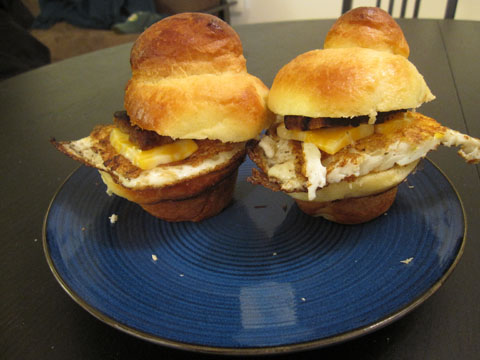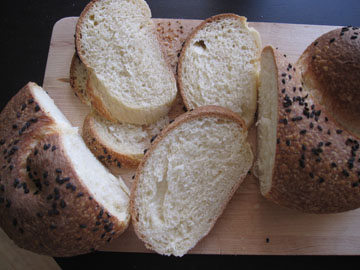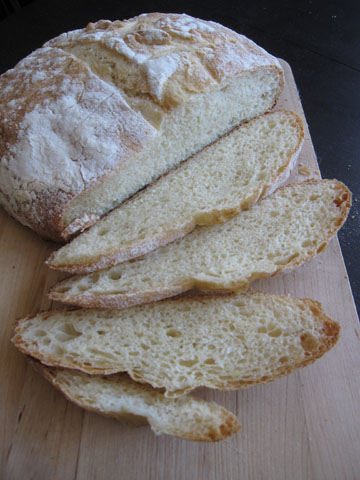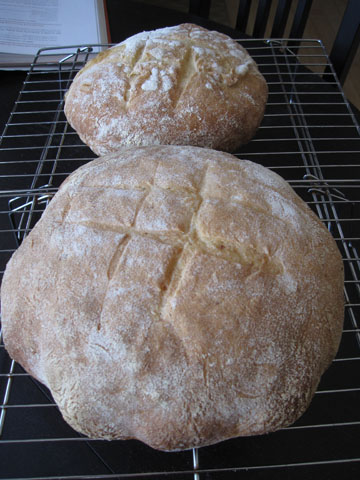Category: food & drink
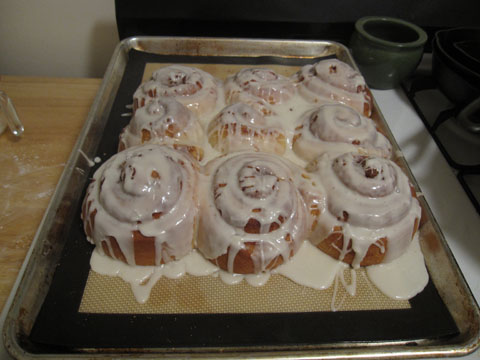
I think the picture kind of speaks for itself. These are the Cinnamon Rolls from the BBA.
Permanent link to this article: https://www.rhinoblues.com/thoughts/2011/02/cinnamon-rolls/

I didn’t go home over the holidays this year, so I had a couple long weekends with not much going on. A perfect time to get back into the BBA Challenge! I decided to go back and try and hit a couple of the breads I had skipped over previously. As I had everything on hand for the Brioche, I decided to start there.
First step was to create a sponge:
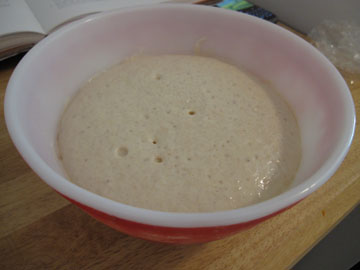
This would get the yeast started on their life journey.
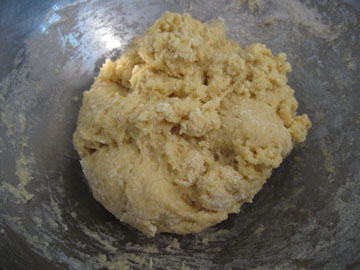
After adding additional flour it would be time to slowly mix in the butter. In the BBA there are three variations of Brioche. Rich Man’s, Middle Class, and Poor Man’s Brioche. I decided to go with the Middle Class variation, partially because I’d be mixing the butter in by hand (instead of having a stand mixer). It took a fair amount of time to mix in a half pound of butter into the dough above. Once that was done I spread out the dough on a sheet pan and let it do a cold fermentation overnight in the refrigerator.
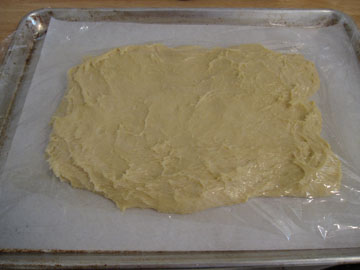
The next day it was time to proof the dough. Because of all the butter in the dough, I’d do the shaping as soon as I removed the dough from the refrigerator. As I don’t have any brioche tins, I improvised with a muffin pan.

After letting the rolls proof and brushing them with an egg wash, it was time for them to go in the oven. They ended up with a “muffin bottom,” but still tasted great.

Of course, I had to take Nicole’s advice and make breakfast sandwiches with them in the morning!
Permanent link to this article: https://www.rhinoblues.com/thoughts/2011/01/brioche/
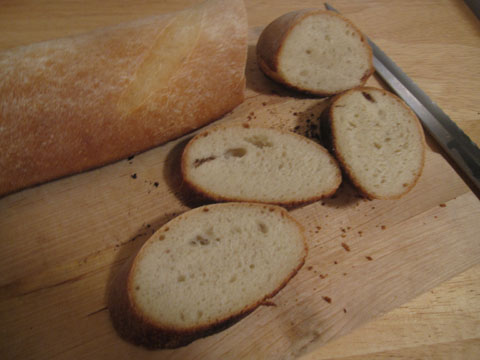
I’d been looking forward to this section of the
BBA from the beginning. Part of the fun was going to be the making of the sourdough starter from scratch. I did run into a little problem when I first got to this section however. The formula for the starter called for pumpernickel rye (a course grind) flour. I went all over LA looking for someone who carried it, but no one seemed to. I almost gave up and ordered online, but by that time I had a trip to Portland coming up, so I decided I’d go out to
Bob’s Red Mill and just pick it up there.
The first step in making the mother starter was to create a seed culture. This process took 4 days.
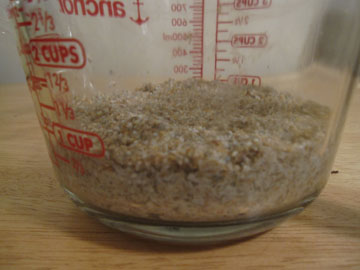 Day 1 – Pumpernickel and Pineapple Juice
Day 1 – Pumpernickel and Pineapple Juice
For the first two days, instead of water, the instructions were to use pineapple juice to hydrate the flour. This is to prevent the development of a bacteria that could inhibit the growth of the yeast later on in the process.
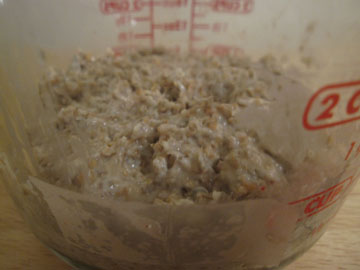
Day 2 – Pumpernickel Rye, Bread Flour, Pineapple Juice
Day 2 introduced regular bread flour to the mixture. Days 3 and 4 introduced more bread flour and goes back to water to hydrate the flour.
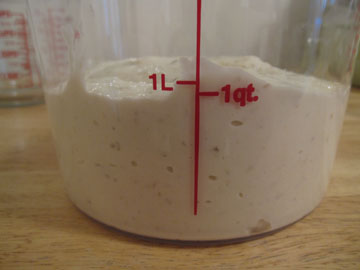
Mother Starter
To create the mother starter, I added a portion of the seed culture to more flour and water and let it rise a few hours before putting it in the refrigerator over night for some slow fermentation.
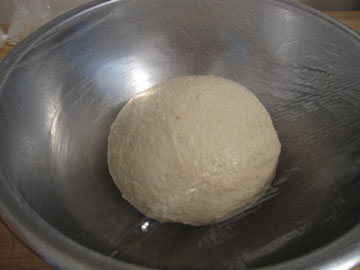 Basic Sourdough rising
Basic Sourdough rising
I do need to figure out the best way to use my mother starter as formulated in the book. I only need a small portion to make the formula for the basic sourdough loaves…so I ended up with a lot of extra starter that wasn’t used. I need to work on understanding the baker’s formula calculations better, so I can keep a smaller starter.
For this batch I decided to shape the sourdough into baguettes:
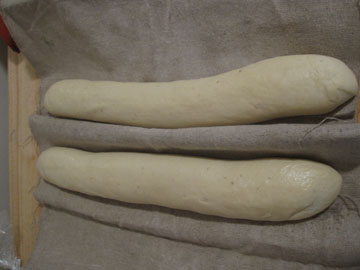 Proofing on the couche
Proofing on the couche
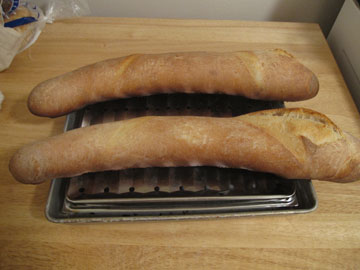
Fresh out of the oven…on my makeshift cooling rack.
I’ve since made a batch shaped in boules. I did like the bread, though it was still pretty dense both times. I think my starter may still need a few more times refreshing to let the flavor develop a little more, but you could definitely tell it was a sourdough bread.
Permanent link to this article: https://www.rhinoblues.com/thoughts/2010/11/basic-sourdough/
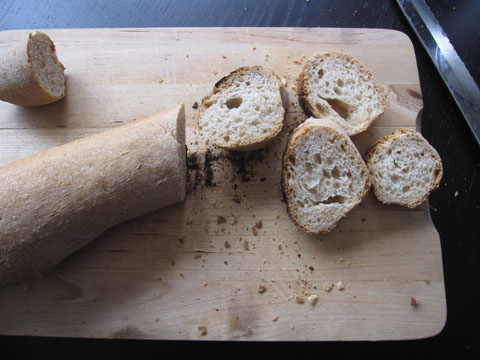
This is another long overdue post. I brought these loaves to a potluck and hike in June. I must get better about posting.
These baguettes are started with a poolish, and that is the main difference between it and the earlier French style baguettes. These also had a bit of sifted whole wheat flour in them, instead of 100% bread flour that the traditional French Bread would have.
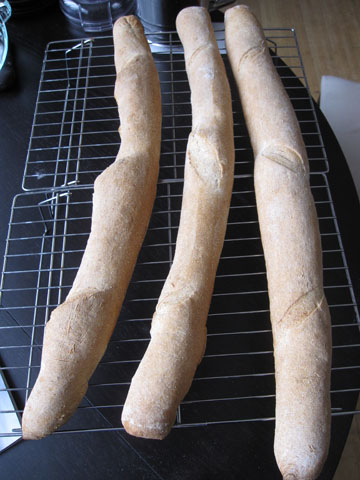
I shaped these loaves to be as big as my oven could handle. These were however the last loaves I made at my old apartment…and as a result are a little longer than I can do with my current oven.
Permanent link to this article: https://www.rhinoblues.com/thoughts/2010/11/poolish-baquettes/
Wow, this post is long delayed. I baked this bread months ago…but such is things when life gets in the way. I do luckily have a few more pictures of baking this bread to help spur my memory though.

I started out with a overnight soak of some oats, polenta, & wheat bran. The next day I mixed in the flour and let it rise.
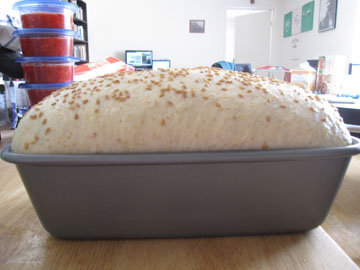
This made a single loaf, and it crested nicely about the lip of the pan. I topped it with flax seed to add yet a little more extra goodness to the multiple grains. (My first batch of strawberry freezer jam is setting in the background!)
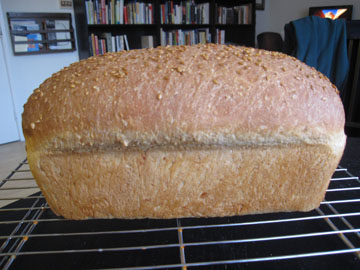
Just out of the oven.
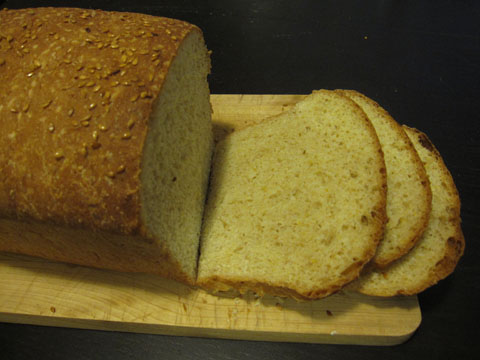
This made great sandwich bread. (I was also told it was good as toast, but I didn’t have any myself.) It was gone before I knew it. I would like to make this again soon as I get back into the baking habit.
Permanent link to this article: https://www.rhinoblues.com/thoughts/2010/08/multigrain-extraordinaire/

We like to make homemade pizzas fairly often, so this formula came at a good time. This dough is meant to be slowly fermented, from the ice cold water used in the mixing, to the at least overnight fermentation in the refrigerator. Unfortunately my hand tossing skills are not up to par yet, so i ended up with the squarish pizza you see above.
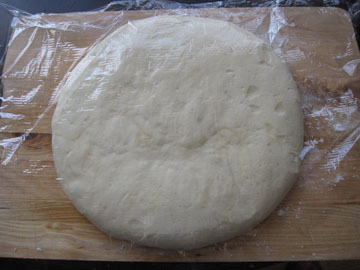
On pizza day, you remove the dough from the refrigerator a couple hours before you will bake the pizza. When I got ready to attempt to hand toss the dough, I had a nice round piece of dough. I need a lot of practice to get the hand tossing technique down though. I get the dough too thin in the center and it tears. In the end…the square pizza at the beginning of this post.
I will have more opportunity to practice however, as I’ve got two more balls of dough in the freezer to use later.
Permanent link to this article: https://www.rhinoblues.com/thoughts/2010/06/pizza-napoletana/
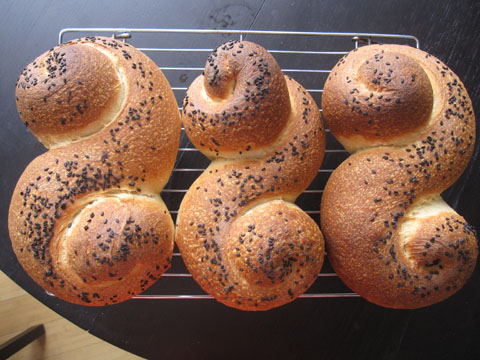
As you can see, this was a uniquely shaped bread. It also took 3 days to make. Day 1 was for the
biga (pre-ferment). On day 2, the rest of the ingredients were mixed and the loaves were shaped. To shape the loaves, I divided the risen dough into 3 similarly sized pieces and shaped them as I would a baguette. Then I curled them in on opposite sides of the loaf to make the S-shape of the loaves. A spray of water and sprinkling of black sesame seeds on top, and the loaves were placed in the refrigerator to retard overnight.
Day 3 was finally baking day and it was worth it. This bread was amazing. A nice nutty flavor from the long ferments. I definitely look forward to making this again.
Permanent link to this article: https://www.rhinoblues.com/thoughts/2010/06/pane-siciliano/
I had to search around to find the
durum flour for my attempt at
Pugliese. The usual suspects had
semolina flour but I needed the finer grind of the
durum. I finally picked some up at
Surfas in Culver City.
The formula called for a mix of durum and bread flour, however I used mostly durum and saved the bread flour to add while kneading. My loaves ended up flattening on the edges when I put them in the oven. The bread had a great flavor to it, especially the crust.
Permanent link to this article: https://www.rhinoblues.com/thoughts/2010/06/pugliese/
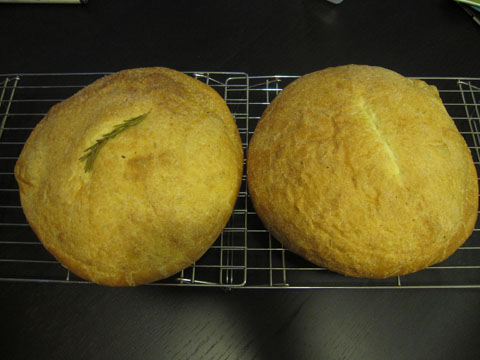
For this bread, we get a new ingredient to play with. Potatoes! I cooked up a batch of Yukon Gold potatoes (From Zuckerman Farms @ the
Hollywood Farmers Market) to make the mashed potatoes for this loaf.
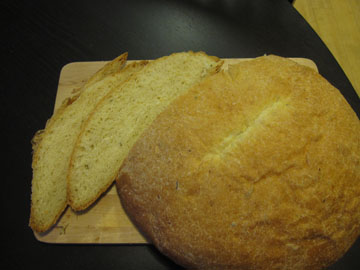
My round loaves didn’t turn out to be as thick in the center as I would have liked, but it tasted good. I spread some fresh avocado on some toasted slices for lunch one day and it was heavenly.
Permanent link to this article: https://www.rhinoblues.com/thoughts/2010/06/potato-rosemary-bread/
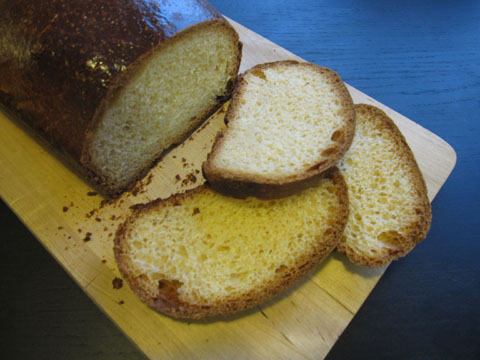
Peter Reinhart describes this bread as the east coast version of the popular Hawaiian style bread on the west coast. They are both sweet breads for sure, but I think this formula at least has a little more fruit forward flavor (the citrus extracts really stay present in the baked loaf). While this loaf uses a sponge, it does not need an overnight rest like many of the other breads I’ve made. The sponge has a relatively large amount of yeast for the size of the sponge.
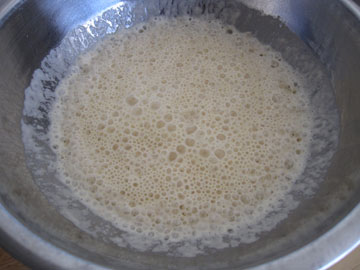
After the sponge is nice and bubbly, it was time to mix the rest of the dough. First step was to mix up some of the liquid ingredients. Eggs, some vanilla, orange, & lemon extract.
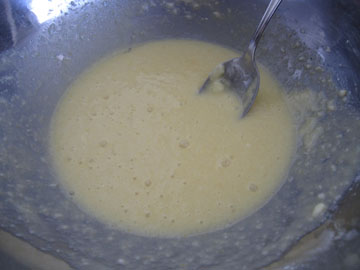
To this mixture I added the sponge and the remaining flour and mixed until the ingredients formed a course ball.
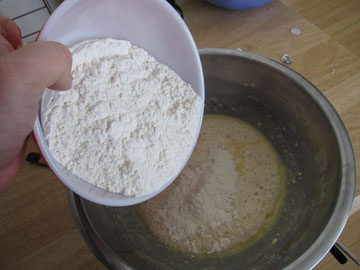
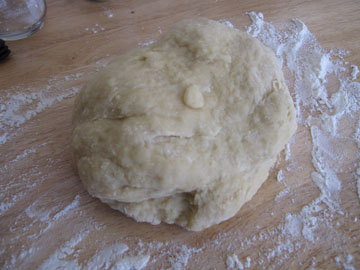
Because this bread has a high fat content, it takes a little more time
to knead than one of the more lean breads (like French Baguettes). I
think I kneaded this for almost 15 minutes. Then it was time to let it rise.
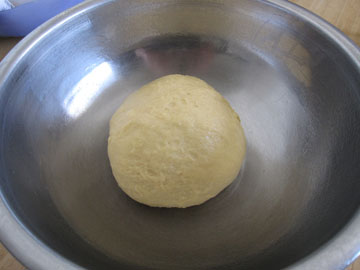
While the formula suggested baking these in round pie pans, I decided i wanted these as sandwich loaves. They took quite awhile to proof, and even then they were a little smaller than I would have liked. The nice deep caramel color of the tops of the loaves were due to an egg wash applied just before baking. Another popular loaf among my co-workers. I’ve already got requests for another batch.
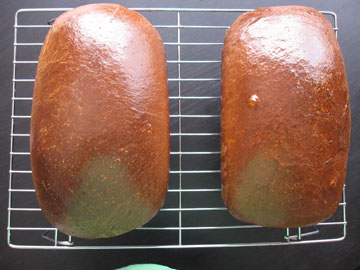
Permanent link to this article: https://www.rhinoblues.com/thoughts/2010/06/portuguese-sweet-bread/








